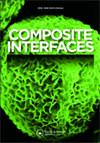Properties of polybutylene succinate and polybutylene succinate -polycaprolactone based composite reinforced with coconut shell particles
IF 2.4
4区 材料科学
Q3 MATERIALS SCIENCE, COMPOSITES
引用次数: 0
Abstract
ABSTRACT In order to increase the interfacial adhesion between polybutylene succinate and coconut shell particles, two kinds of chemical treatment of coconut shell particle were carried out. Firstly, a 5% sodium hydroxide treatment and secondly, a 2% sodium hydroxide plus silane coupling agent treatment. The possibility of increasing matrix adhesion has also been explored through addition of polycaprolactone to polybutylene succinate as a matrix. Composites were produced using extrusion prior to injection moulding. The results show that, compared with neat polybutylene succinate, composites with low percentage of particle loading have a higher tensile strength and strain at break despite their lower elastic modulus. A higher elastic modulus can be obtained for composites with higher particle loadings through sacrifice of their ductility. The same trend is observed for composites with the polymer-blend matrix. Scanning electron micrographs show good adhesion between particle and matrix for particles that undergo the second treatment. At low percentage of particle addition, the crystallinity of the composites is higher than the neat polybutylene succinate, however melting temperature is less affected by the addition of reinforcement. Rheological properties such as storage modulus, loss modulus and complex viscosity of the composites are higher than for neat polybutylene succinate. GRAPHICAL ABSTRACT椰壳颗粒增强聚琥珀酸丁烯和聚琥珀酸丁烯-聚己内酯基复合材料的性能
摘要为了提高聚丁二酸丁二烯与椰壳颗粒之间的界面附着力,对椰壳颗粒进行了两种化学处理。首先,5%氢氧化钠处理,其次,2%氢氧化钠加硅烷偶联剂处理。通过将聚己内酯添加到聚丁二酸丁二酯中作为基质,还探讨了增加基质粘附性的可能性。复合材料是在注塑成型之前用挤压法生产的。结果表明:与纯聚琥珀酸丁二烯相比,低颗粒加载比例的复合材料具有更高的拉伸强度和断裂应变,但弹性模量较低;高颗粒载荷的复合材料可以通过牺牲其延性来获得较高的弹性模量。聚合物共混基体的复合材料也有同样的趋势。扫描电镜显示,二次处理后的颗粒与基体之间具有良好的附着力。当颗粒添加量较少时,复合材料的结晶度比纯丁二酸聚丁二烯高,但增强剂的加入对熔融温度的影响较小。该复合材料的存储模量、损失模量和复合粘度等流变性能均高于纯聚琥珀酸丁二烯。图形抽象
本文章由计算机程序翻译,如有差异,请以英文原文为准。
求助全文
约1分钟内获得全文
求助全文
来源期刊

Composite Interfaces
工程技术-材料科学:复合
CiteScore
5.00
自引率
3.80%
发文量
58
审稿时长
3 months
期刊介绍:
Composite Interfaces publishes interdisciplinary scientific and engineering research articles on composite interfaces/interphases and their related phenomena. Presenting new concepts for the fundamental understanding of composite interface study, the journal balances interest in chemistry, physical properties, mechanical properties, molecular structures, characterization techniques and theories.
Composite Interfaces covers a wide range of topics including - but not restricted to:
-surface treatment of reinforcing fibers and fillers-
effect of interface structure on mechanical properties, physical properties, curing and rheology-
coupling agents-
synthesis of matrices designed to promote adhesion-
molecular and atomic characterization of interfaces-
interfacial morphology-
dynamic mechanical study of interphases-
interfacial compatibilization-
adsorption-
tribology-
composites with organic, inorganic and metallic materials-
composites applied to aerospace, automotive, appliances, electronics, construction, marine, optical and biomedical fields
 求助内容:
求助内容: 应助结果提醒方式:
应助结果提醒方式:


